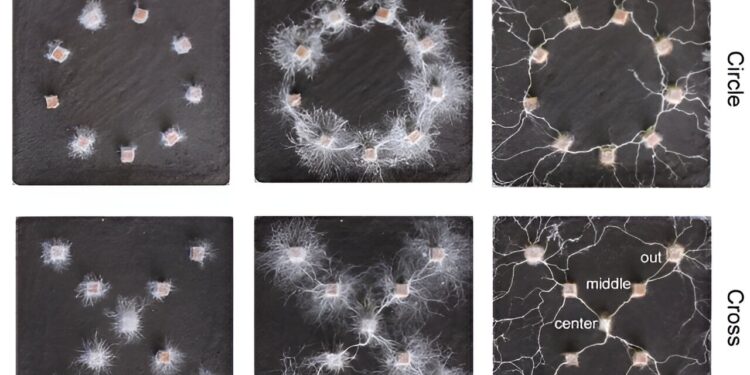Fungal mycelial networks connecting wooden blocks arranged in the shape of a circle (left) and a cross (right). Credit: Yu Fukasawa et al.
Can brainless organisms still show signs of intelligence? Researchers from Tohoku University and Nagaoka College had this question in mind when they conducted a study aimed at measuring decision-making processes in fungi. Although it may sound like science fiction, this level of basal cognition is possible even in fungi.
“You would be surprised how capable mushrooms are,” notes Yu Fukasawa of Tohoku University. “They have memories, they learn, and they can make decisions. Frankly, the differences in how they solve problems compared to humans is mind-blowing.”
Mushrooms grow by releasing spores, which can germinate and form long spider-like threads underground (a mycelium). We usually only see tiny mushrooms on the surface, not realizing that there is a vast network of interconnected mycelium beneath our feet. It is through this network that information can be shared, much like neuronal connections in the brain.
A study, published in Fungal ecology on September 12, 2024, examined how a wood-decaying mycelial network responded to two different situations: blocks of wood placed in a circle or a cross. For example, if mushrooms did not exhibit decision-making abilities, they would simply spread from a central point without considering the position of the blocks. Surprisingly, this is not what the researchers witnessed.
For the cross layout, the degree of connection was higher in the four outermost blocks. It was hypothesized that this was because the outermost blocks could serve as “outposts” for the mycelial network to embark on foraging expeditions, so denser connections were needed.
In the circle layout, the degree of connection was the same in any given block. However, the dead center of the circle remained clear. It has been proposed that the mycelial network sees no benefit in overexpanding into an already well-populated area.
These results suggest that the mycelial network was able to communicate information about its environment across the entire network and change its growth direction accordingly based on its shape.
Our understanding of the mysterious world of fungi is limited, especially when compared to our knowledge of plants and animals. This research will help us better understand how biotic ecosystems work and how different types of cognition have evolved in organisms.
More information:
Yu Fukasawa et al, The arrangement of spatial resources influences both network structures and activity of fungal mycelia: a form of pattern recognition?, Fungal ecology (2024). DOI: 10.1016/j.funeco.2024.101387
Provided by Tohoku University
Quote: Results suggest fungal mycelia can “recognize” shapes (October 8, 2024) retrieved October 8, 2024 from
This document is subject to copyright. Except for fair use for private study or research purposes, no part may be reproduced without written permission. The content is provided for informational purposes only.



